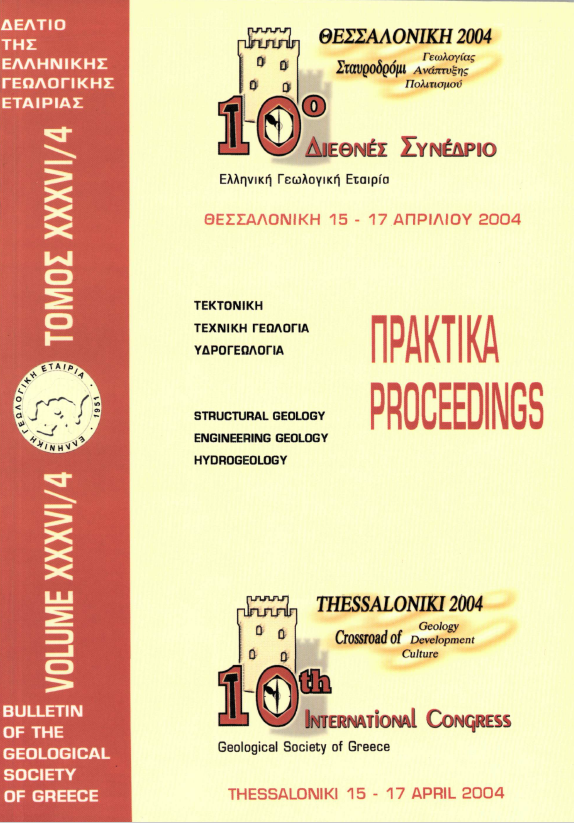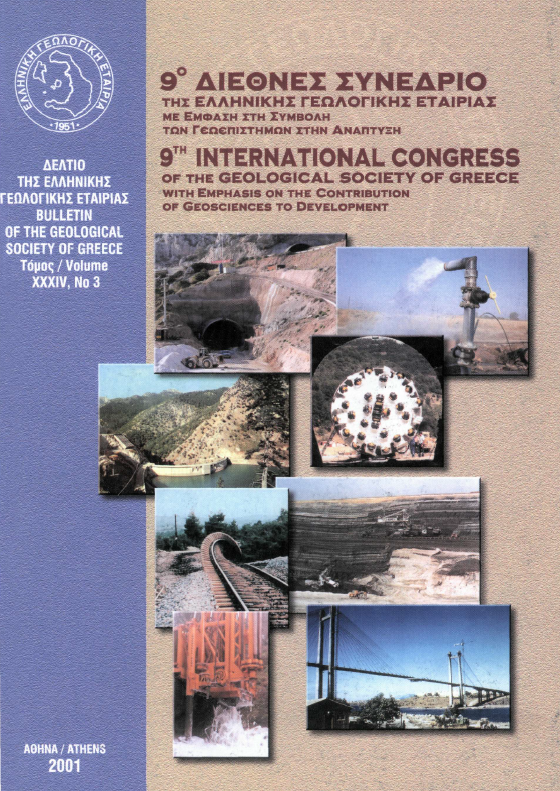RΟCKFALL S DURING THE EARTHQUAKE OF 14/8/03 AND PROBABLE SOLUTIONS AT THE UPPER LEVEL OF DRIMONA S VILLAGE SLOPE, MUNICIPALITY OF SFAKIOTON LEUKADA ISLAND
Abstract
Big rocky blocks of indicative dimensions of 2.5*2.5x2.5 m, were activated and fell down-slope during the earthquake (Ms=6.4) of 14/8/03 from the upper part of the hill slope behind Drimon village (Municipality of Sfakiotes in Leukada island). The area is geologically composed of thick bedded white neritic limestones, of Pantokratoras unit (Upper Triassic age). The slope angle is roughly 50° to the NW, at the place of rockfall activation. The limestone is cut in blocks of edge 2-3 m long, due to the geometry of the tectonic discontinuities and the orientation of bedding. In this paper, the mechanism of rockfalls was studied regarding to their horizontal and vertical jumps as well as their kinetic energy. Furthermore, the type, the geometry, the place of installation and the necessary absorbing capacity of barriers were studied for restraining future rockfalls in the area. According to our study, the blocks are necessary to be tied, in place, at the upper part of the slope, using bolting, wire cable and wire netting techniques. Nevertheless, two elastic metallic barriers, approximately 100 m long and 5 m high, able to absorb kinetic energy of 3000 kJ, were decided to be installed on the slope, for the case that blocks, of mean dimensions 2.5x2.5x2.5 m, fall down. These barriers will be placed at horizontal distances of 38.22 m and 94.08 m, from the rockfalls starting point.
Article Details
- How to Cite
-
Βογιατζής Δ., Δημητρίου A., Παπαθανασίου Γ., Χρηστάρας Β., Καντηράνης Ν., Φιλιππίδης A., & Μωραΐτη E. (2004). RΟCKFALL S DURING THE EARTHQUAKE OF 14/8/03 AND PROBABLE SOLUTIONS AT THE UPPER LEVEL OF DRIMONA S VILLAGE SLOPE, MUNICIPALITY OF SFAKIOTON LEUKADA ISLAND. Bulletin of the Geological Society of Greece, 36(4), 1735–1742. https://doi.org/10.12681/bgsg.16587
- Section
- Engineering Geology, Hydrogeology, Urban Geology

This work is licensed under a Creative Commons Attribution-NonCommercial 4.0 International License.
Authors who publish with this journal agree to the following terms:
Authors retain copyright and grant the journal right of first publication with the work simultaneously licensed under a Creative Commons Attribution Non-Commercial License that allows others to share the work with an acknowledgement of the work's authorship and initial publication in this journal.
Authors are able to enter into separate, additional contractual arrangements for the non-exclusive distribution of the journal's published version of the work (e.g. post it to an institutional repository or publish it in a book), with an acknowledgement of its initial publication in this journal. Authors are permitted and encouraged to post their work online (preferably in institutional repositories or on their website) prior to and during the submission process, as it can lead to productive exchanges, as well as earlier and greater citation of published work.






